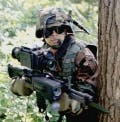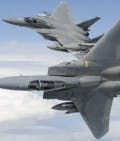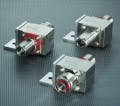COTS technology and rich data combine to deliver high-fidelity flight training and simulation
Increasing the military’s Aviation Training and Readiness (T&R) is a growing priority for the U.S. Department of Defense (DOD). Military organizations are turning to industry for innovative electronic flight training, flight simulation, and mission rehearsal for honing core skills and capabilities of soldiers, sailors, and airmen.
The face of combat -- including military tactics, weaponry, and environments -- changes the battlefield becomes more complex, and so, too, do the simulation and training systems devised to increase military preparedness.
For more on simulation and training, please see stories entitled Flight training and simulation designers are pressed for ever-more features and graphics, and Simulation and training technology pushes graphics to create the most realistic learning environment possible.
The DOD, dedicated to advancing military training, is investing in putting the latest and greatest flight training and simulation tools in soldier’s hands, in classrooms and in theater, which is accelerating technology and acquisition cycles. “The government is really moving very quickly now to get new capabilities into [simulation and training] systems,” explains Frank Delisle, vice president of engineering and technology at L-3 Link Simulation & Training in Arlington, Texas.
“Scenarios are entirely different today,” Delisle says. “It’s not your traditional military scenario with a tank down the road. Given the urban nature of the conflicts now, soldiers are running into civilian areas with lots of cars and people, and the bad guys are in there somewhere. All that now has to be represented in training scenarios, and you need high definition and rich content to make that happen. You now have to create [simulation and training] environments that are very confusing -- city environments populated with hundreds or thousands of entities.”
Army advancements
Officials at the U.S. Army Modeling and Simulation Office (AMSO) in Washington have taken a page from the DOD’s handbook and have contracted Alion Science and Technology in McLean, Va., to support the office’s oversight role for managing modeling and simulation processes throughout the Army.
The AMSO coordinates, integrates, and synchronizes strategic modeling and simulation efforts across the Army to ensure unity of effort and purpose, says a representative. Office personnel also develop and implement a unified strategy to equip the Army with modeling and simulation capabilities in support of operating and generating force functions.
Under a $3.6 million contract, Alion professionals will assist in the AMSO and the Modeling and Simulation Proponent Office’s mission to train and supply qualified modeling and simulation professionals to the Army, recruit and manage the modeling and simulation community to best meet the Army's warfighting needs, conduct research and analyze technical requirements, and produce a trained Army modeling and simulation community.
“With the Army’s increasing focus on using modeling and simulation for decision support, mission planning, training, and more, it’s essential that they have the tools and capability to effectively introduce and manage relevant processes,” says Timer Keenan, Alion senior vice president and manager of the Strategic Operations Group. “Alion’s support of modeling and simulation integration will help move AMSO closer to its goals of extending modeling and simulation resources throughout the Army.”
Networked training
Army officials also have invested in the first full-motion, high-fidelity simulators to support UH-60M aircrew training. L-3 Link Simulation & Training (L-3 Link) will provide three UH-60M operational flight trainers (OFTs) in support of training services for the U.S. Army’s Flight School XXI program, based on a contract modification from Computer Sciences Corp. in Falls Church, Va.
The first UH-60M OFT, to be installed at Flight School XXI’s Warrior Hall, is expected to enter accreditation testing and achieve ready-for-training status in the fourth quarter of 2012. To date, L-3 Link has delivered or is in the process of delivering 35 training devices to Flight School XXI.
“When these simulation services are provided to Flight School XXI, they will be provided with the highest fidelity UH-60M Operational Flight Trainers in the world,” says Bob Birmingham, president of L-3 Link. “UH-60M Operational Flight Trainers will enable aircrews to gain aircraft-equivalent training for all modes of flight, developing the skills they will need to successfully undertake sling load, shipboard, and troop movement operations.”
UH-60M aircrews can view out-the-window computer-generated imagery through wide field-of-view and chin window visual displays. Its high-fidelity software simulates the UH-60M’s engine, electrical, hydraulic, navigation, and communication systems, as well as aircraft survivability equipment. A physics-based blade element model, electrically driven servo flight control system, and cyclic and collective controls that replicate UH-60M cockpit control also contribute to the high-fidelity training environment.
Next-gen fighters
“Fifth-generation fighters require a high-density threat environment and increased simulation fidelity to truly challenge a pilot’s ability to implement the full capability of aircraft systems,” explains Todd Kortbein, vice president of business development for range systems at DRS Training and Control Systems in Fort Walton Beach, Fla.
Military and aerospace customers are requesting a combination of live training and “constructive” and “virtual” simulation, Kortbein says. “Constructive simulation allows combat pilots to fly and fight against targets [airborne and ground] that appear real on aircraft seekers and sensors, but in reality are provided by onboard simulations that stimulate appropriate sensors and HUD/cockpit symbology for the pilots to maneuver, fire, and train against.” This simulation and training method increases efficiency by providing more intercepts per mission and reduces fuel consumed per combat training mission, he says.
“In this environment, adversary aircraft are replicated and displayed purely via simulations, giving the warfighter an extremely cost-effective way to train,” Kortbein continues. The same virtual simulation technology can be employed in advanced trainer aircraft using multifunction displays; training aircraft don’t require real sensors [e.g., real radars] to perform mission training, thereby saving acquisition costs. “Virtual simulation,” he explains, enables real aircraft to fly against pilots that are training in ground-based flight simulators via a data link/ground network. This method enables the pilot in the flight simulator to experience increased training fidelity because he/she is flying against a real maneuvering aircraft.
The global positioning system (GPS) enables training anywhere in the world at any time, which leads to the name “rangeless training,” Kortbein adds. Advanced airborne processors and digital simulations deliver a high-fidelity simulation performance that closely replicates actual weapon performance. Additionally, 100 players or more can train simultaneously in the same mission without the risk of compromising mission tactics to hostile forces, thanks to advanced data link networks and improved security features.
Mil-aero customers are requesting encryption and multiple levels of security (MLS), Kortbein reveals. “Low observable platform technology performance, for example, cannot be easily obtained and analyzed by hostile forces when mission data is encrypted. MLS allows forces to train with friendly/coalition forces without providing 100 percent of their mission parameters to those same forces while they train together (certain parameters can be filtered/withheld from these forces). In this way, combat air forces of the world can train with allies, but not sacrifice all of their tactics/weapon capabilities to their allies.”
DRS air combat training systems are designed to bring live-virtual-constructive technology to virtually all types of aircraft by using current and future training instrumentation data links and processors, including advanced modeling of weapon countermeasures (e.g., chaff, flare, and ECM/ECCM) and enhanced modeling of atmospheric effects associated with weapon simulations. In fact, DRS provides the latest generation of live air combat training instrumentation solutions for U.S. fighter aircraft, and to qualified U.S. allies and coalition partners. DRS Air Combat Training Systems can be carried as an external store in several air-to-air missile form factors or internally to the aircraft as an avionics box.
“Today’s flight training and simulation technologies allow aircrews to experience first-hand the fog of war, in a controlled training environment, and provides them a venue to sort through the myriad combat related challenges a routine training environment can’t, nor will ever sufficiently replicate,” Kortbein continues. “This type of augmented training has been shown to cultivate superior kill ratios for those pilots well-versed in this technology, resulting in lives saved and reduced aircraft losses. These technologies are also a force multiplier by allowing pilots to get the most out of their aircraft and associated weapon systems via repetition and fine tuning not possible without these systems.
“As portrayed in the movie Top Gun, our training instrumentation provides a simulated weapon engagement environment allowing pilots to employ weapons, and kill or be killed in the simulated haze of combat,” Kortbein says. “Our instrumentation allows real aircraft, with real pilots to fly exactly as they would in real combat. The only difference is, instead of real weapons, weapon simulations are used to simulate the outcome of combat."
DRS air combat training systems capture the data for display, enabling pilots to analyze their performance -- what they did right, what they did wrong, and how they could have done things better -- after the mission has been completed. Post-mission critiques can now be compiled and presented in as little time as one hour after landing -- something that used to take many hours or even days. “It allows pilots to get better training with less hours spent in mission debrief and more hours spent with their families,” Kortbein describes. “It’s a quality-of-life issue for combat pilots.”
Realism in the absence of aircraft
Live training and mission rehearsal exercises, though beneficial to warfighter readiness, can be expensive and even cost-prohibitive in the presence of a downturned economy and growing budgetary restrictions. The DOD and military organizations continue to invest in and modernize traditional training institutions and the electronic training and simulation systems employed therein.
The mil-aero customer’s focus is on how to improve simulation devices' training and readiness capability continuously? The answer: commercial off-the-shelf (COTS) technology. “We have taken a lot of the advancements in computer graphics and gaming technologies and leveraged that to provide rich content,” L-3 Link's Delisle says.
The emphasis on training and readiness in the acquisition world over the past few years has enabled industry to be “a lot more proactive in bringing technologies to the problem, opposed to the acquisition process trying to dictate the technology,” Delisle says. “They want to leverage commercial technology; industry now can be a lot more aggressive providing solutions so the warfighter can get closer to what he can get on his gaming console. Gaming is not the same level of simulation you have to have for mil-aero, but the underlying technologies still provide us the framework to use. The gaming world doesn’t care about reality in the behaviors of the systems. We always have to make sure we represent the simulations and sensor capabilities with physics-based reality or pilots will get killed; they will think their systems are better than they are in the real world.” Furthermore, in a flight simulator, the content has to be processed in real time, such that there is no lag or latency from the pilot’s actions and maneuvers to when he would see the results, he says.
High-fidelity future
“The future is exciting,” Shank predicts. He is seeing more joint forces training: “not just pilots training by themselves, but rather coordinating training across pilots, ground warriors, and other ground-, air-, and maritime-based vehicles, across multiple disciplines. In the future, coordinating simulation training exercises in virtual environments will be possible with simulation platforms.
“In addition, simulation and training has traditionally been confined to dedicated rooms that require installed equipment. Today, the military wants to train and rehearse for missions remotely, near the area of engagement,” says Pratish Shah, director of marketing at Quantum3D. “Newer simulation and training equipment must be easy to set up, and portable to send to any location worldwide.”
Quantum3D has designed its ExpeditionDI simulator to be easily transported and set up in an hour for ground warrior training. The company is also investing in making mission rehearsal a reality, whereby our military pilots, tank commanders, and ground troops rehearse for specific missions. It involves joint training and simulation, on-the-fly database (satellite imagery and 3D content) generation, and portable equipment where pilots and warriors can train in the field.
Light detection and ranging (LIDAR) is perfect for rapid database generation, says Shah. “Quantum3D has invested heavily in algorithms, applications, hardware, and system technologies that would allow the military to take LIDAR source data and convert it on-the-fly into a simulation database. This has the possibility to allow pilots and ground warriors to train using visuals that were captured not days or weeks ago, but hours earlier. With on-the-fly database generation, our military pilots and ground warriors can rehearse with the latest data to help increase their chances for success.”
“If you look at today’s computational and display systems, we are getting new capability every six months--that’s how fast the turn is. Companion with that the ability to tap into the tools that come out of the commercial gaming industry, which continues to produce more and more content: highly realistic models of vehicles and people, facial expressions, behaviors, and crowds,” Delisle says. “Continuing to tap into the commercial world is a big benefit.” L-3 Link, he describes, can pipe realistic models and actual satellite information of specific areas of the world into training and simulation systems.





